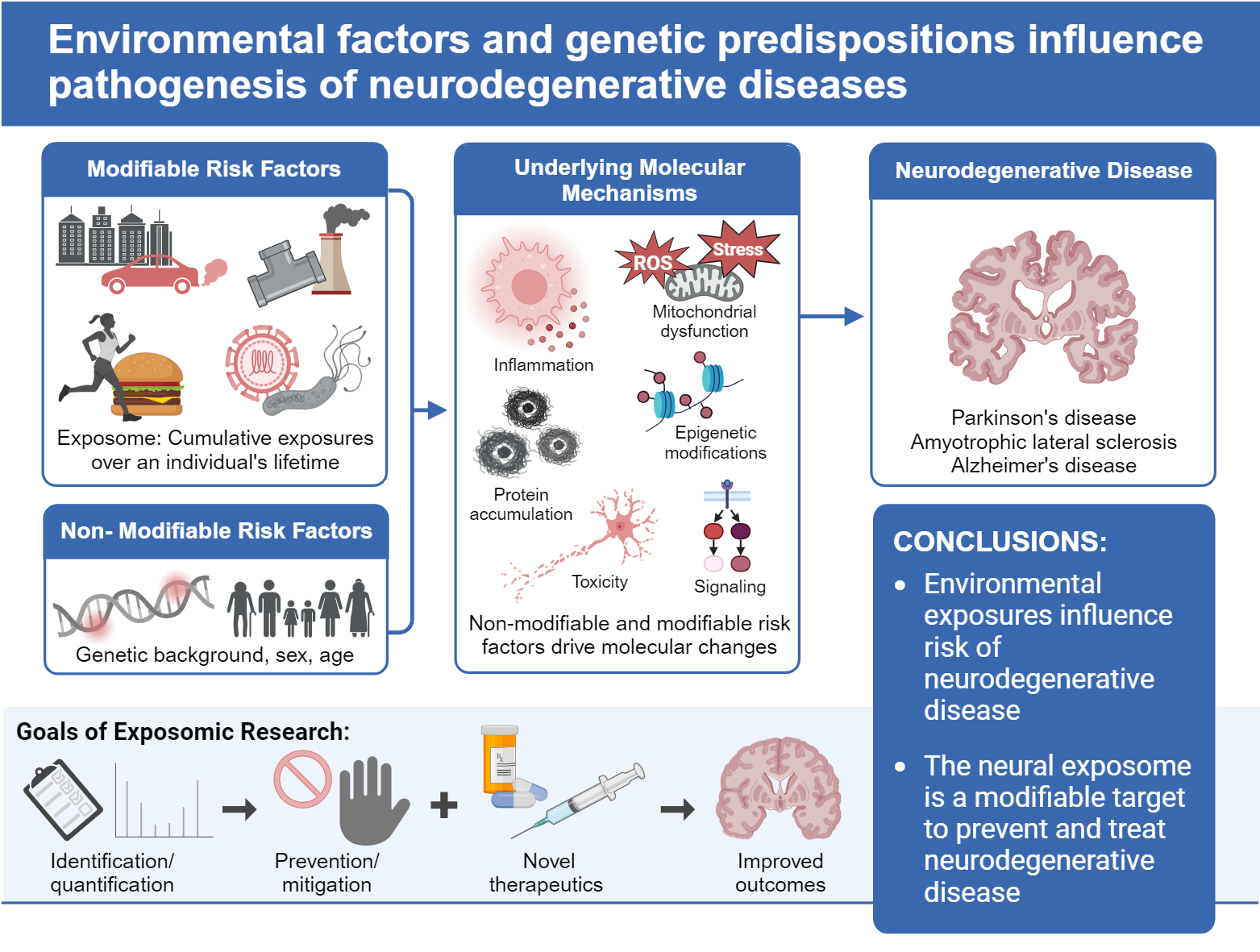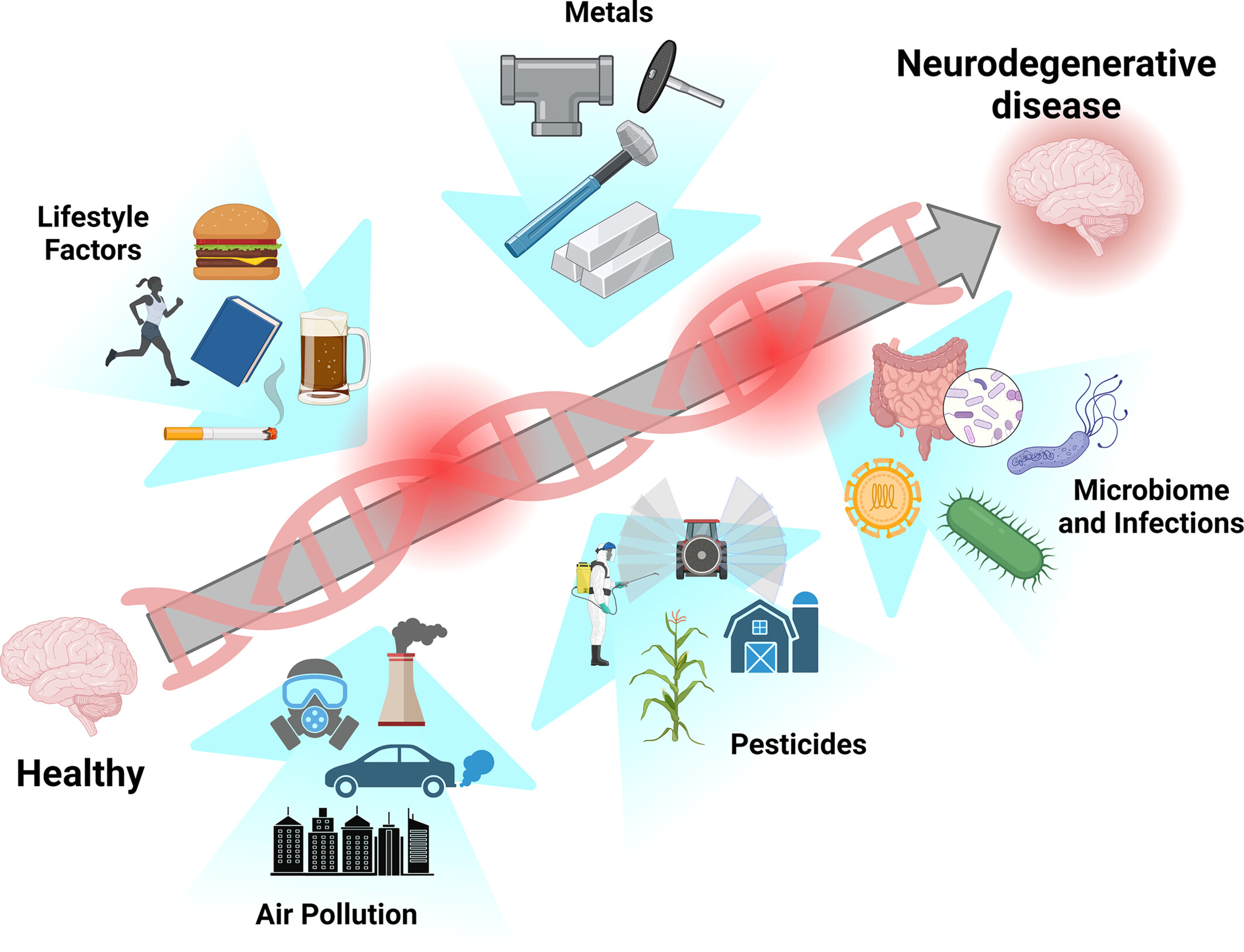
It is becoming increasingly clear that the exposome—the full spectrum of environmental exposures that shape a person’s life—plays an active part in the health of individuals. While much has been written about the exposome, it is an emerging area of research in the context of neurodegenerative disease. A team of NeuroNetwork authors led by Stacy Jacoby, Ph.D., and Eva Feldman, M.D., Ph.D., reviewed the state of research on the subject. “From pollutants to lifestyle choices, there is growing evidence that these factors may play a critical role in conditions like Parkinson’s disease (PD), amyotrophic lateral sclerosis (ALS), and Alzheimer’s disease (AD),” explains Dr. Jacoby, Managing Director of the NeuroNetwork for Emerging Therapies. “However, researchers are still unraveling how our environmental surroundings can contribute to the development of these devastating diseases.“
Key points from the review:
The Neural Exposome includes all exposures that influence nervous system health and disease, including pollutants, industrial and agricultural chemicals, toxins, lifestyle and social factors, diet, the microbiome, and infection.
 Figure 1, Annals of Neurology
Figure 1, Annals of NeurologyHow it affects neurodegenerative disease:
Parkinson's Disease (PD):
- Pesticide exposure is one of the most identified risk factor for the disease.
- Metal and industrial chemical exposure may be linked to PD as well.
- Several studies note alterations in the gut microbiome and metabolome of PD patients compared with healthy controls and exposure to oral antibiotics, such as macrolides and lincosamides, can increase risk.
- The enigmatic relationship between smoking and PD has stirred considerable controversy within the clinical and research communities. A substantial body of evidence suggests a protective association, revealing a decreased risk of PD associated with cigarette smoking, passive smoking, and chewing tobacco. However, the inherent health risks associated with smoking make it a complex and paradoxical avenue of investigation.
- The Mediterranean diet, Mediterranean-DASH Intervention for Neurodegenerative Delay diet, and high vitamin E and C intake positively correlate with decreased risk and later age-of-onset for the disease. Caffeine consumption and a history of competitive sports are protective against cognitive decline in PD as well.
ALS:
- Air pollution is a notable contributor to in the development of ALS. Air pollution also appears to aggravate ALS symptoms, as exposure to higher particulate matter levels increases the risk of ALS-related emergency department and hospital visits.
- Exposure to neurotoxic pesticides is also associated with increased ALS risk.
- Analyses of occupational histories found that employment in the agricultural sector and occupational exposure to pesticides are higher in the ALS versus healthy control groups.
- Residence in agricultural areasis a risk factor for non-hereditary ALS.
- In the United States, ALS risk is positively associated with exposure to glyphosate (trade name Roundup) and 2,4-D, two of the most commonly used herbicides.
- Metal exposure is also considered a potential ALS risk factor—hobbies or occupations involving metal exposure, particularly lead, are associated with increased risk of ALS and reduced survival after diagnosis.
- Trauma events, occupational exposure, and lifestyle factors, such as certain hobbies, have also been explored as potential contributors to ALS risk. However, it is essential to remember that research in this area is still evolving, and no definitive conclusions have been reached.
- Prior traumas, such as head and spinal injury, electric shock, and electrical burns, are identified as risk factors for ALS, with ALS risk increasing with the number of traumatic events.
- In recent years, a growing body of evidence has suggested a potential link between engaging in soccer and football and an elevated risk of ALS.
- Occupations in hunting, forestry, fishing, construction, mechanics, laundering, packaging, and military service, particularly tactical operations and those associated with exposure to extremely low-frequency magnetic fields, correlate with increased risk.
- Smoking is known to generate oxidative stress and inflammation, which could potentially contribute to neurodegenerative processes in ALS.
- Differences in gut microbiome composition are observed between ALS participants and healthy controls. The composition of the ALS gut microbiome changes over the course of the disease, with a shift from protective species to neurotoxic and pro-inflammatory groups. Unfortunately, probiotic supplementation in ALS patients did not bring gut microbiome compositions back to that of healthy controls or influence disease progression.
Alzheimer's Disease (AD):
- The 2020 Lancet Commission on Dementia Prevention added air pollution as one of three new modifiable risk factors for dementia due to robust emerging data supporting its association with AD onset.
- Pesticide and metal exposures, as in ALS, have likewise gained interest for their potential association with AD risk, but equivocal results for pesticides indicate that additional studies are needed.
- Like PD and ALS, lifestyle factors contribute to AD risk. Obesity, diabetes, hypertension, physical inactivity, alcohol consumption, social isolation, and smoking are among the modifiable factors noted in the Lancet Commission report, and recent data continue to support these observations.
A look to the future:
With all of this in mind, we need urgent measures to regulate these harmful environmental factors that contribute to conditions such as PD, ALS, and AD. What does this look like? “Robust public health initiatives should be established to raise awareness regarding the potential risks associated with specific environmental exposures and promote lifestyle changes that minimize these risks,” explains Dr. Feldman. “Simultaneously, we need collaborative efforts between the scientific community, policy makers, and industry stakeholders to develop and implement stringent regulations that curb the release of harmful substances into our environment. As companies in the past have concealed potential health risks, it is also critical to remain vigilant in scrutinizing industries for transparency in reporting potential risks associated with their products. These steps must be taken sooner rather than later, as the seeds of future generations of individuals with neurodegenerative diseases may already be planted. By fostering a comprehensive, multidisciplinary approach, we can strive to create a healthier environment and mitigate the risk factors contributing to the alarming rise of neurodegenerative diseases in our communities.”
Acknowledgments: The authors thank Dr Masha G. Savelieff for expert editorial support. Funding support during the preparation of this manuscript was provided by the National Institutes of Health (R01ES030049, R01NS127188, K23ES027221), the Centers for Disease Control and Prevention (R01TS000289, R01TS000327), the Alzheimer's Association Clinician Scientist Fellowship (AACSF-22-970586), the Robert and Katherine Jacobs Environmental Health Initiative, the Andrea and Lawrence A. Wolfe Brain Health Initiative, the Frank L. and Helen Gofrank Foundation Research Program in Alzheimer's Disease and Brain Health, the Robert E. Nederlander Sr. Program for Alzheimer's Research, the Sinai Medical Staff Foundation Research, the Handleman Emerging Scholar Program, the Taubman Foundation, and the NeuroNetwork for Emerging Therapies at the University of Michigan.
Sakowski SA, Koubek EJ, Chen KS, Goutman SA, Feldman EL. Role of the Exposome in Neurodegenerative Disease: Recent Insights and Future Directions. Ann Neurol. 2024 Feb 27. doi: 10.1002/ana.26897. Epub ahead of print. PMID: 38411261.
